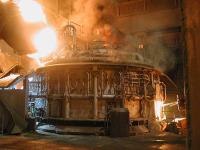 Add My Company
Add My Company
Sign In
The Magical Electric Arc Furnace
29-08-2017

While there are many techniques for creating, processing and refining steel, each one is a large industrial process that literally accounts for centuries of continued learning and experimentation. Some processes are discovered by applying new scientific principles, whilst others are careful adjustments of the way things have been done previously.
One of the more modern ways of making steel is via the EAF – or Electric Arc Furnace. Although Electric Arc Furnace may sound like a 1970’s prog-rock band, EAF was actually started in the first decade of the 20th Century in the USA. The big US steel mills were still responsible for the majority of output, but after 1945, the low cost of setting up an EAF made them a more attractive proposition. For long running mills, however, Electric Arc Furnaces were seen as slower and more energy intensive and it’s only since the 1980’s that there’s been a significant expansion in EAF.
One of the major modern benefits of the electric arc is in homogenising solid steels. Taking scrap steel or blocks of ferro-alloys could at times be problematic as it wasn’t always possible to determine the grade or make up of the material. Now, scrap is melted using the electric arc, then cleansed with a series of special chemical agents called fluxes, which remove undesirable elements such as sulphur and phosphorus. This means that by using EAFs, scrap steel becomes 100% recyclable and also reduces the amount of energy required over processing iron ore into steel.
Modern economics also plays a large part of the desire to use Electric Arc Furnaces as a means of production. Whilst at one point, the industrialisation of the world’s largest nations meant a constant demand for steel, this has since cooled. Once infrastructure like railway networks, electricity grids and bridges have been created, the worldwide demand drops off – traditional furnaces don’t have the ability to vary their output and the flexibility of being able to start and stop the electric arc rapidly based on demand is much more economically sensible. The reduced amount of space required for the electric arc also means it can be set up much closer to the end site, reducing time and transportation costs.
Although for many years, EAF was viewed as mainly suitable for speciality steels, it could be that as the world become less reliant on fossil fuels and renewable electricity is more and more readily available, the ability of the steel industry to adapt by using electricity is another way to reduce the environmental impact of steelmaking. If you also include the energy savings offered by keeping steel 100% recyclable and able to be used again and again, then the future is certainly looking interesting for the process!
Photo credit: By GMH official (Own work) [CC BY-SA 3.0], via Wikimedia Commons
For more information on The Magical Electric Arc Furnace talk to West Yorkshire Steel Co Ltd
Enquire Now
List your company on FindTheNeedle.

